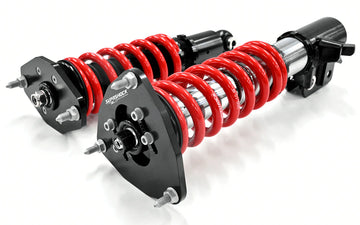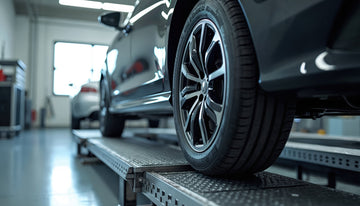Coilovers require regular maintenance to uphold their performance, safety, and durability. By investing time and effort into their upkeep, drivers can enjoy a smoother ride, improved handling, and greater peace of mind on the road.
A vehicle's suspension system plays a vital role in providing a comfortable and controlled ride. It absorbs the impact of uneven road surfaces, maintains tire contact with the road, and enhances stability and handling. Coilovers, as an integral part of the suspension system, directly influence these factors.
There are several reasons why coilover maintenance is important, including;
Wear and tear
Over time, coilovers experience wear and tear due to the constant stress and strain they endure. The springs, shock absorbers, and other components can become worn, lose their effectiveness, or develop issues that affect their performance. Neglecting maintenance can lead to degraded suspension performance, compromised handling, and increased risks on the road. Avoid harsh impacts like potholes or speed bumps whenever possible to prevent damage to your coilovers. Drive cautiously on rough roads and uneven surfaces.
Environmental factors
Coilovers are exposed to various environmental elements during vehicle operation. Dust, dirt, road salt, and moisture can accumulate on the coilovers, leading to corrosion and accelerated wear. Additionally, extreme temperatures and harsh driving conditions can further impact the performance and durability of the coilovers.
Performance and safety
Regular suspension system maintenance is crucial for maintaining optimal performance and safety. When coilovers are properly maintained, they help to provide a smooth and controlled ride, improve handling characteristics, and ensure even tire wear. Neglecting maintenance can result in a compromised suspension system, leading to uncomfortable rides, reduced vehicle control, and potentially hazardous situations.
Cost savings
Addressing coilover maintenance proactively can also lead to cost savings in the long run. By detecting and addressing issues early on, you can prevent further damage that may necessitate expensive suspension repair or even complete replacement of the coilovers. Proper suspension system maintenance helps extend the lifespan of coilovers, minimising the need for premature replacements.
If you participate in motorsports activities or track days, consider upgrading certain components of your suspension system for improved performance and durability under high-stress conditions.
How do I know if my coilovers are experiencing wear and tear?
Being able to recognise the signs of worn coilovers is crucial for timely maintenance and avoiding potential complications. Here are some common indicators that your coilovers may require attention;
Increased body roll
One noticeable sign of worn coilovers is increased body roll during cornering or sudden maneuvers. If you experience excessive leaning or a feeling of instability when navigating turns, it may suggest that the coilovers are no longer providing adequate support and damping. This can compromise your vehicle's handling and overall stability.
Bumpy or uncomfortable rides
Worn coilovers often result in a harsh and uncomfortable ride quality. If you notice an increase in vibrations, jolts, or a rough sensation when driving over uneven surfaces, it could be a sign that the shock absorbers within the coilovers have deteriorated. This can lead to reduced suspension travel and diminished impact absorption. Avoid harsh impacts like potholes or speed bumps whenever possible to prevent damage to your coilovers. Drive cautiously on rough roads and uneven surfaces.
Uneven tire wear
Examining your tires for uneven wear patterns can provide valuable insights into the condition of your coilovers. Worn or damaged coilovers may cause uneven tire wear, such as excessive wear on the inner or outer edges of the tires. This can occur due to the lack of proper suspension alignment and compromised weight distribution.
Excessive noise or clunking sounds
Worn coilovers can produce noticeable noises, such as clunks, rattles, or squeaks, especially when driving over bumps or rough terrain. Pay attention to unusual noises or vibrations while driving, as they could indicate a problem with your suspension system. These noises may indicate worn-out bushings, loose components, or damaged shock absorbers. If you hear any unusual sounds, it is advisable to have your coilovers inspected promptly. Address these issues promptly by consulting a professional mechanic if necessary.
Leaking fluid
Inspecting your coilovers for signs of fluid leakage is another important step in identifying potential wear. Leakage of oil or hydraulic fluid from the shock absorbers can suggest seal failure or internal damage. The presence of fluid on the coilovers or surrounding areas is an indication that suspension system maintenance or repair is needed.
Loss of suspension adjustability
If your coilovers feature adjustable settings for ride height, damping, or rebound, and you find that these adjustments are no longer responsive or have limited impact on the suspension characteristics, it may be a sign of wear. Loss of adjustability can occur due to worn-out internal components or inadequate lubrication.
While these signs can help you identify potential coilover wear, it is recommended to consult a professional suspension specialist or mechanic for a thorough inspection. They can assess the condition of your coilovers, diagnose any underlying issues, and provide appropriate recommendations for maintenance, suspension repair, or replacement.
How do I maintain my coilovers?
Maintaining your coilovers is crucial for ensuring their optimal performance and longevity. To maintain your coilovers, it is important that you do the following:
Conduct regular inspections
Conduct visual inspections of your coilovers at regular intervals. Look for signs of leaks, damage, or corrosion on the shock absorbers, spring rate adjustment, and other components. Check that all mounting hardware is securely fastened and free from excessive wear. Checking and tighten all mounting bolts and hardware associated with your coilover system. Loose bolts can cause noise, vibrations, or even catastrophic failure while driving.
Clean your coilovers
Remove dirt, debris, or road grime from the coilovers using a soft brush or cloth. Use a mild detergent or specialised coilover cleaner for stubborn contaminants. Rinse thoroughly with water to remove all cleaning agents.
Apply lubrication
Apply a silicone-based lubricant or specialised suspension grease to the moving parts of the coilovers. Focus on lubricating adjustment threads, pivot points, and the shock absorber rod. Lubricate all moving parts of the coilover system, including adjustment knobs and threaded collars, with a suitable lubricant to prevent rusting and ensure smooth operation.Avoid using petroleum-based lubricants as they can deteriorate rubber components.
Observe your adjustment settings
Familiarise yourself with the adjustment settings of your coilovers, such as ride height, damping, and rebound. Follow the manufacturer's instructions for making adjustments. Avoid extreme lowering that may compromise ride quality or cause clearance issues. Regularly check and suspension tuning based on your driving preferences and conditions.
Protect your coilovers from environmental factors
Apply a protective coating or wax to the external surfaces of the coilovers to shield them from dirt, moisture, and road salt. Consider using coilover covers or boots for additional protection against debris and corrosive elements.Apply a protective coating or wax to the external surfaces of the coilovers to shield them from dirt, moisture, and road salt. Consider using coilover covers or boots for additional protection against debris and corrosive elements.
Replace worn components
Promptly address significant wear, leaks, or damage observed during inspections. Consult with a professional suspension specialist or the coilover manufacturer to determine if any components need replacement. Follow the manufacturer's guidelines or seek expert assistance for proper installation.
Get regular professional servicing
Consider having regular maintenance performed by a qualified technician who specializes in suspensions systems. They will be able to identify potential issues before they become major problems. Schedule periodic professional inspections and servicing of your coilovers. This is particularly important if you notice persistent issues or significant changes in performance. Professional expertise can identify potential problems not apparent during regular inspections and may involve specialised maintenance tasks such as rebuilding or re-valving the shock absorbers.
By following these maintenance practices and referring to the specific instructions provided by the coilover manufacturer, you can keep your coilovers in optimal condition, enjoy a smoother ride, and extend their lifespan.
Coilover Maintenance FAQs
How often should I inspect and maintain my coilovers?
It is recommended to inspect your coilovers regularly, ideally every few months or at least once a year. However, the frequency of maintenance may depend on factors such as driving conditions, mileage, and the manufacturer's recommendations. Follow the recommended maintenance schedule provided by the manufacturer for specific instructions on servicing intervals and procedures.
Can I clean my coilovers with a pressure washer?
While it's important to clean your coilovers, using a pressure washer is not recommended. The high-pressure water stream can potentially damage sensitive components, such as seals or electrical connections. It's best to clean them manually using a soft brush, cloth, and appropriate cleaning agents.
Should I perform maintenance on my coilovers myself or seek professional assistance?
Coilover maintenance can vary in complexity, so it depends on your comfort level and expertise. Basic tasks such as visual inspections and coilover cleaning can be done by most car owners. However, more advanced car maintenance, such as rebuilding or re-valving the shock absorbers, will require professional assistance. Proper alignment after installing new coilovers is necessary to ensure optimal performance and tire wear. It's recommended to have a professional perform this task using specialised equipment.
Can I adjust the ride height and damping settings of my coilovers on my own?
Yes, most coilovers are designed to be adjustable, allowing you to fine-tune the ride height and damping settings according to your preferences. However, it's important to follow the manufacturer's instructions and guidelines for making adjustments. If you're unsure, it's best to consult with a professional or refer to the manufacturer's documentation.





